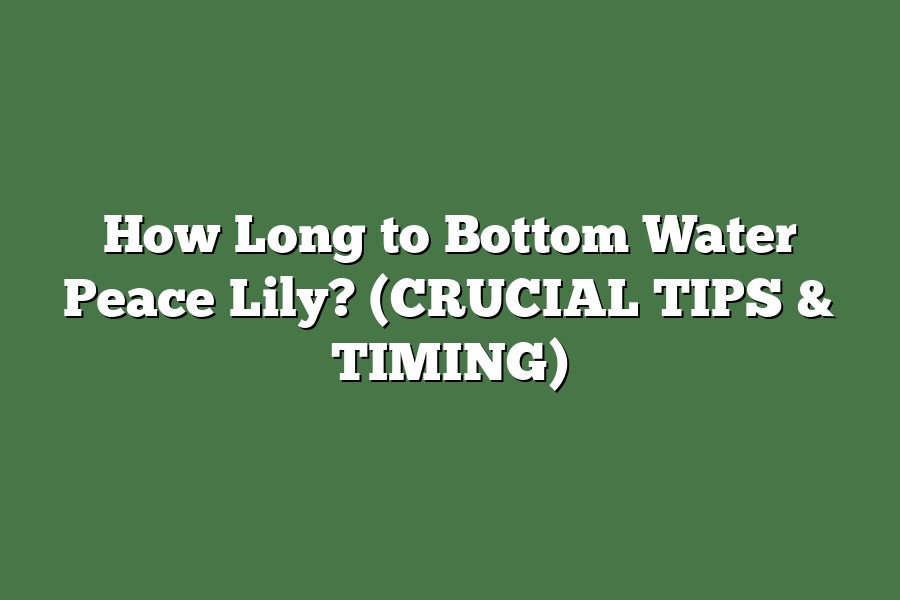To bottom water a peace lily effectively, allow the plant to sit in a tray of water for around 15-30 minutes. This allows the roots to absorb water from the bottom up, preventing overwatering and promoting healthy growth. Be sure to empty any excess water from the tray after the designated time to avoid waterlogging the plant.
Hello plant lovers!
Today, we’re delving into the art of bottom watering for your Peace Lily.
Discover tips to keep it thriving, avoid overwatering, and ensure just the right hydration.
Let’s care for your Peace Lily together!
Table of Contents
The Benefits of Bottom Watering for Peace Lilies
As a proud plant parent, you want to ensure your peace lily thrives in the best possible conditions.
One simple but effective method to achieve this is through bottom watering.
Let’s dive into the benefits of bottom watering for your peace lilies.
1. Enhanced Root Hydration
When you bottom water your peace lily, you provide direct hydration to the roots, where it’s needed most.
Unlike top watering, which often leads to water pooling on the surface, bottom watering allows the roots to absorb moisture gradually.
This method ensures that your plant is receiving adequate hydration without the risk of overwatering.
2. Prevention of Moisture-Related Diseases
By bottom watering your peace lily, you reduce the risk of moisture-related diseases such as root rot and fungal infections.
When you pour water directly into the plant’s saucer, the roots absorb only the water they need, while excess water remains in the saucer, away from the roots.
This prevents the roots from sitting in waterlogged soil, which can lead to various health issues for your plant.
3. Encourages Healthy Root Growth
Bottom watering encourages your peace lily to develop a robust root system.
By allowing the roots to seek out water at the bottom of the pot, you promote downward root growth.
This results in a healthier and more stable root structure, which is crucial for the overall health and vitality of your plant.
4. Minimizes Fertilizer Runoff
When you bottom water your peace lily, you also reduce the risk of fertilizer runoff.
Unlike top watering, where nutrients can leach out of the soil before the plant has a chance to absorb them, bottom watering ensures that the plant’s roots come into direct contact with the fertilizer solution.
This maximizes nutrient absorption and minimizes waste, leading to healthier and more vibrant growth.
5. Conserves Water
Bottom watering is not only beneficial for your peace lily but also for water conservation.
By pouring water directly into the saucer and allowing the roots to absorb it as needed, you eliminate the risk of water splashing or evaporating during top watering.
This method helps you save water and ensures that your plant receives the optimal amount of hydration without wastage.
bottom watering is a simple yet effective technique that can have numerous benefits for your peace lily’s health and growth.
By enhancing root hydration, preventing moisture-related diseases, encouraging healthy root growth, minimizing fertilizer runoff, and conserving water, you can ensure that your peace lily thrives in the best possible conditions.
Give bottom watering a try and watch your plant flourish!
How Long to Bottom Water a Peace Lily: Timing and Tips
When it comes to caring for your peace lily, proper watering is key to ensuring its lush green leaves and beautiful white blooms thrive.
Bottom watering is a popular method that can help prevent issues like root rot and overwatering.
But how long should you bottom water your peace lily?
Let’s dive into the timing and tips to keep your plant happy and healthy.
Understanding Bottom Watering
Bottom watering involves pouring water into a saucer or tray beneath the plant, allowing the roots to soak up moisture from the bottom up.
This method ensures that the roots receive adequate hydration without the risk of water sitting on the surface, potentially causing root damage.
Timing Is Key
So, how long should you let your peace lily bottom water?
The general recommendation is to let the plant sit in the water for about 10-15 minutes.
This timeframe allows the roots to absorb enough moisture without being oversaturated.
Overly prolonged exposure to standing water can lead to waterlogged soil and root suffocation.
Monitoring Moisture Levels
To determine the correct watering schedule for your peace lily, always check the moisture level of the soil before watering.
Stick your finger about an inch deep into the soil – if it feels dry, it’s time to water.
If it’s still moist, hold off on watering until the top layer feels slightly dry to the touch.
Avoiding Standing Water
While bottom watering is an effective method, it’s crucial to avoid leaving your peace lily sitting in water for too long.
After the 10-15 minute soaking period, be sure to discard any excess water from the saucer or tray.
Allowing the plant to remain in standing water can lead to root rot, fungus, and other detrimental issues.
Tips for Success
Here are some additional tips to ensure successful bottom watering for your peace lily:
- Use room temperature water to prevent shock to the plant.
- Aim to water your peace lily in the morning to allow excess moisture to evaporate throughout the day.
- Consider incorporating a pebble tray beneath the plant to enhance humidity levels.
- Adjust your watering frequency based on environmental factors like temperature and humidity.
By following these timing and tips for bottom watering your peace lily, you can help promote healthy growth and vibrant blooms for this popular indoor plant.
Remember, consistency and observation are key when it comes to maintaining the well-being of your peace lily.
Monitoring Your Peace Lily During Bottom Watering
When it comes to caring for your peace lily, monitoring its condition during bottom watering is crucial to ensuring its health and vitality.
In this section, we’ll explore the importance of keeping a close eye on your plant during the watering process.
Why Monitoring is Essential
Monitoring your peace lily while bottom watering allows you to observe how the plant is responding to this watering method.
By paying attention to the following factors, you can ensure that your peace lily remains healthy and thriving:
Soil Moisture Levels: Checking the soil moisture levels before and after bottom watering can help you determine if your peace lily is receiving adequate hydration.
Root Health: Monitoring the roots of your peace lily can provide insights into whether they are healthy and free from rot or other issues.
Leaf Color and Texture: Observing the color and texture of the leaves can indicate whether your peace lily is getting enough water or if it is experiencing any nutrient deficiencies.
How Often to Monitor
Regular monitoring is key to maintaining the health of your peace lily.
Here are some guidelines on how often you should monitor your plant during bottom watering:
Daily Check-ins: Consider checking on your peace lily daily, especially when implementing a new watering routine or during periods of extreme temperatures.
Weekly Observations: Take the time to do a more thorough inspection of your peace lily’s condition on a weekly basis. Look for any changes in growth, color, or overall health.
Signs to Watch Out For
Keeping a close watch on your peace lily can help you identify any issues early on.
Here are some common signs to watch out for while monitoring your plant during bottom watering:
Wilting Leaves: If you notice wilting or yellowing leaves, it may indicate that your peace lily is not receiving enough water.
Root Rot: Dark, mushy roots are a sign of root rot, which can occur if the plant is overwatered or if there is poor drainage.
Droopy Appearance: A droopy appearance in your peace lily may signal dehydration and the need for more frequent watering.
monitoring your peace lily during bottom watering is a proactive approach to plant care that can help you address any issues before they escalate.
By staying attentive to your plant’s needs and observing any changes, you can ensure that your peace lily thrives in its environment.
Stay tuned for more insights on caring for your peace lily in the next section.
Risks of Overwatering and Waterlogging in Peace Lilies
Hey there, plant enthusiasts!
Today, we’re diving deep into the potential risks associated with overwatering and waterlogging your beloved peace lilies.
It’s time to understand why too much of a good thing can actually harm these resilient beauties.
The Perils of Overwatering
We all want to shower our plants with love and care, but did you know that overwatering can spell disaster for peace lilies?
Here’s why:
Root Rot: Peace lilies are particularly susceptible to root rot when sitting in waterlogged soil for extended periods. This common issue occurs when roots are deprived of oxygen, leading to their deterioration and ultimately plant decline.
Nutrient Imbalance: Excess water can flush out essential nutrients from the soil, disrupting the delicate balance required for your peace lily to thrive. Without proper nourishment, your plant may show signs of stunted growth or yellowing leaves.
Pest Infestations: Standing water can become a breeding ground for pesky pests like fungus gnats and root mealybugs. These unwanted visitors can wreak havoc on your peace lily’s health, causing stress and potential damage.
Understanding the Dangers of Waterlogging
So, what’s the deal with waterlogging and why should you be wary of it?
Let’s break it down:
Suffocating Roots: When soil becomes waterlogged, it essentially suffocates the roots of your peace lily by depriving them of oxygen. This lack of aeration can hinder root function and nutrient uptake, leading to overall plant distress.
Fungal Infections: Moist conditions created by waterlogging provide the perfect environment for fungal infections to thrive. Peace lilies can fall victim to diseases like Pythium root rot and Rhizoctonia root rot, which can quickly spread and cause irreversible damage.
Wilting and Decline: As a result of waterlogging, your peace lily may exhibit symptoms of wilting, yellowing leaves, and overall decline in health. These visible signs act as red flags, indicating the urgent need for corrective action to save your plant.
while it’s crucial to keep your peace lilies hydrated, it’s equally important to strike the right balance and avoid the perils of overwatering and waterlogging.
Stay tuned for our next section, where we’ll explore the best practices for watering your peace lilies to ensure their longevity and vibrancy.
Until next time, keep nurturing those green companions with care!
Final Thoughts
Bottom watering your peace lily can be a game changer for keeping your plant happy and healthy.
By allowing the roots to absorb water at their own pace, you’re promoting strong growth and preventing issues like overwatering and waterlogging.
Remember, 20-30 minutes is the sweet spot for bottom watering, ensuring optimal hydration without the risk of drowning your plant.
So, next time you’re giving your peace lily a drink, give bottom watering a try and watch your plant thrive.
Your green companion will thank you for it!

